Everything these six weeks taught me

“The Rule of the Loop: The more times you test and improve your design, the better your game will be.” – Jesse Schell (The Art of Game Design: A Book of Lenses)
I think I now have a deeper understanding of the above sentence by Jesse Schell pointing out the nature of design. I would like to share my thoughts on this quote and use the last six weeks of design loop to look back my personal work in the team and reflect on what these six weeks has taught me.
Team Formation
Starting with the team’s name, Maureen, Nicholas, Rachael, Joshua, and I got together to name our game design team. We had quite a few nice options, like Gaia Games Studio, GeoForce Studio, and Terra Learner Labs. Luckily, my proposed team name “ShowMeGeo Studio” was selected. It shows our identity, aligns with client expectations, and reflects our game’s goal—to introduce Geological majors. I am proud to be the creator of the team’s name.
Play More Games Before Designing One
Before we started designing the game, Dr. Oprean asked us to find, play, and share games related to geological majors. Through this exploration, I noticed many games were related to maps, possibly because maps are easier to design into games or simulations.
With the insights gained from playing games shared by other team members, I confirmed my assumption about the common use of maps in geological games. This led us to ponder: What other possibilities could we explore in geological game design? With this question in mind, we began researching our audience.
Understanding the audience is crucial for guiding our next steps in game development. By gaining a deeper insight into the interests, educational backgrounds, and gameplay preferences of our target players, we can tailor our game to better meet their needs and enhance their learning experience.
Researching Learner Persona
During the persona research phase, I drew upon my extensive experience as a secondary school science teacher to contribute to our team’s creation of learner personas. With 16 years of teaching in K-12 schools, I have observed many students choosing geography or related majors as they advance to college or graduate school. Recently, one of my former students, who is now attending the University of Nevada, secured a NASA research grant for his groundbreaking black hole research. Zhang, who was once just a curious young student in my science class in Beijing, China, is an example of the type of student who can significantly inform the development of our learner personas.
Given my background in geography and firsthand observations of secondary school students who pursue it as a major or research direction, I am well-equipped to assist my colleague Maureen in developing the learner persona, with a particular focus on those younger than college age. I am eager to contribute to the descriptions of our learner personas, particularly for high school and middle school students, leveraging real-world examples and experiences to ensure our game design effectively resonates with and educates this demographic.
Game Design
Starting from last semester, in Dr. Oprean’s course “Design Games for Learning”—the one before the current advanced course I am taking—I have been pondering the differences between games, movies, instructional design, and cooking. These thoughts frequently emerged in my mind, sparked by the many similarities between these disciplines. While writing a blog to review the past six weeks, these thoughts visited me again.
In my opinion, game design closely resembles movie design, instructional design, and even cooking. Why? Because all involve preparation: a game blueprint, screenwriting, a lesson plan, or a cooking procedure. The clients of the game, the viewers of the movie, the students in a class, and the tasters for a dish are the targets for these designs. All need interactive improvements if the creators wish to present the best to the end user.
You can find lovers of good food, elegant instructions, impressive movies, and playful games everywhere. Additionally, I think good games can also be attractive movies, informative instructions, and high-quality “spirit food,” especially in the case of story games like those ShowMeGeo Studio has been designing.
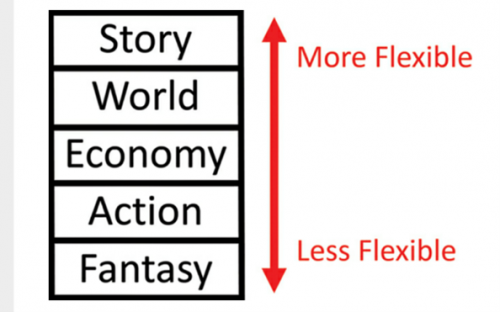
Schell, J. (2019). The Art of Game Design: A Book of Lenses, Third Edition (3rd edition). A K Peters/CRC Press. )
Jesse Schell used a figure (Schell, 2019) to illustrate the five important elements that comprise story games: Story, World, Economy, Action, and Fantasy. From this figure, I could confirm my imagination about the relationships between games, movies, instruction, and food once again. Because again, games, movies, teaching, and food can all contain the same five elements, and those elements can be improved upon by the designer.
For the importance of the story design in a game, Schell (2019) pointed out, “ When developing a game with a compelling story, it can be very tempting to start not by designing a game but by writing your story.” Now, let me focus on the story design.
Game Storming
Where do good game ideas come from? Kultima concluded some points from the interviews that, “Good ideas were seen as inspiring for others to immediately build on top of them. It was seen as beneficial when a description gave enough information for other to imagine the idea, but enough space for them to develop it further. The bouncing of ideas would expose that quality of an idea.” (Kultima, n.d.) During a weekend brainstorming session inspired by Maureen, I developed a game idea while cycling on the MKT trail in Columbia, MO. This idea was influenced by geographic facts displayed on the trail (figure 3), leading to the creation of our game “CoMo Valley,” which incorporates different spaces and historical periods.
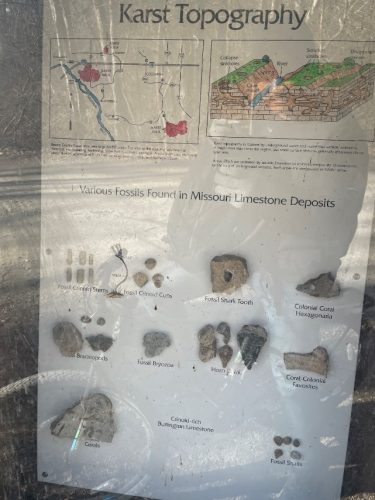
The Design Loop
When the five of us began sharing our specific ideas on a shared Google Doc, we quickly encountered a “chicken or egg” dynamic. This dynamic persisted in the following weeks as we developed the Storyboard, Objective Mapping, Assessment Plan, and the Concept Testing Report. We often debated which component should be introduced first: game mechanics, instructional objectives, assessment plans, or storyboard design? There is no definitive answer, as the ideal approach may vary from one game studio to another.
I confirmed this assumption during a guest lecture with Greg Marlow, who has extensive experience in both the game industry and academic settings focused on game design. The design process is inherently iterative—meaning the more times you test and refine your design, the better your game will become (Schell, 2019) . This also aligns with Dr. Oprean’s initial introduction to the course, where we embraced the concept of being in a continuous loop of development and improvement.
One key realization I had during our game development process is the importance of continually revisiting the problem description. I found myself rereading it numerous times to ensure that our design stayed aligned with the initial goals and objectives. This constant reference helped keep our project on the right track, ensuring that every element of the game design directly addressed the core issues we set out to solve. It served as a crucial checkpoint that guided our development decisions and helped maintain a clear focus throughout the iterative design process.
Problem Description
- There has been a steady decline in Geography majors over the years despite the real-world need for keeping the long-standing discipline alive. To better understand the problem, you can read a bit more on the decline here.
- Very few games and simulation solution exist to engage in the practice of Geography.
- Geography is a multi-faceted discipline with very diverse areas of practice, many of which are often confused with other discipline in Environmental Sciences and GeoScience.
- Geography in practice differs from what is taught in K-12 classrooms (K-12 classrooms focus on facts-based information where Geographers synthesize and draw meaning from human and environment interactions).
During this development phase, Dr. Soren Larsen shared his expectations for the game, emphasizing the importance of enhancing students’ abilities to analyze spatial patterns. The challenge was to design a game that not only helps novice learners understand the role of geographers but also trains students majoring in geography to analyze spatial patterns on thematic maps effectively.
To address this dual need, I suggested a multi-level design approach. This strategy allows us to cater to both novice and professional learners within the same game environment. By implementing different levels of complexity and challenge, we can ensure that our game is accessible yet sufficiently challenging to engage and educate players at various stages of their educational journey. This approach aims to provide a seamless learning curve that enhances the educational value of the game for all users.
Reflecting on My Process
As an experienced secondary teacher, I brought a lot of first-hand educational experience to our design process. Despite challenges in communication due to language barriers, I learned the importance of patience and persistence in game design.
New Content
The past six weeks have taught me the significant impact of patience in designing games, and the immense effort required to create games like “Stardew Valley” as an individual.
This process has been a valuable part of my learning and growth as a game designer, helping me to understand the intricate relationship between different creative processes and the importance of iterative design in game development.
References
Vocabulary Detective Presentation
Video Transcript:
Hi everybody, I am Yupei. In this presentation, I am going to introduce my game Vocabulary Detective created by Construct 3 game Engine. This presentation is also the part 2 of my level 5 assignment in the course of Designing Games for Learning advised by Dr. Oprean.
In my presentation, you will see the following topics:
Game title: Vocabulary Detective
Overview of the game
- Game Goal: In this game, you will play the role of a detective to match the right graphics with the right words, complete word spellings, and compose sentences using given words. The sentence you ultimately compose will contain clues to the thief’s hiding place, based on clues, you will find the thief as a successful detective.
Describe the narrative: It’s a game blending realism and fantasy, set in an elementary school named “G school”.
Characters introduction:
The main character is a 2nd-grade student, who is a vocabulary detective. Besides the main character, there is a thief hiding somewhere in “G school”, along with a teacher and a police officer who are searching for the thief.
The thief presents a challenge in the game, designed to arouse players’ passion for playing and learning. The teacher and the police officer are Non-player characters who are also very important components of this educational game. In real life, it is not recommended for kids to confront criminals directly. The right way for them in this kind of situation is to report to school faculties or police officers. The protagonist in our game is a fictional character with special abilities to tell more information from English words and sentences. The game you are about to play is the first episode of this game series.
Game Background Introduction:
One day, a thief stole items from a primary school, some items were missing, and many items in the classroom and on the campus were made messy by the thief as well. Teachers and policemen are reorganizing the items and searching for the thief on the campus. The player will assume the role of a special detective – vocabulary detective, who can find the secret behind the letters, words and sentences. With the broad knowledge of vocabulary and strong intuition of language, can the detective find the clues of the thief?
Learning objective: 2nd Grade students will be able to compose a simple English sentence by using the given words.
Core Loop (How to play)
During the game playing, the player will experience three game levels. Firstly, to push the graphics to the relative English words, once a graphic matches to the correct word, the player gets the reward points. In this level, the player will learn or review the English words and remember their meanings. Second game level, the player will push the missing letters to finish the word spellings they have seen in the first level. In this level, the players will get more chances to be familiar with the words. Third level, based on understanding the meanings of the words and their spellings, the player will push the words to the right places to finish an English sentence. The finished English sentence will tell the clues of the thief’s hidden place. The players will find the thief by correctly understanding the meaning of the English sentence. Finally, the thief will be caught by the policemen with the help of the vocabulary detective and teachers.
Keep an eye on the time while you are playing. You need to finish each level in 99 seconds. Do not waste too much valuable time, or you might let the thief escape.
This is a “Sokoban style” game, meaning you can use the four arrow buttons to move the vocabulary detective around in the game.
Now, let me show you quickly about the real game setting. You can go to the game website to start the game. Once you launch the game, you will read the brief instructions of how to play, which will also remind the players of the game goals. Read the instruction, then go to play level 1. The game scenarios are quite straightforward where you can explore and do some trials and errors as you wish.
When you have an idea about how to match the graphics, control the vocabulary detective to push the graphics to match the relative words. Each correct match will earn you 10 points, while each incorrect match will deduct 10 points from your total. Additionally, if you make a wrong match, you will have to replay the level from the beginning. After finishing all the matches, you can use the exit to go to the next level.
The same rules are used in the different levels, but the challenges are becoming harder and harder. For level 2, you need to finish the word spelling with the right missing letters. Based on your memory about the words in level 1, you can tackle the problems in level 2. Now, you not only remember the meaning of the words, but will also be familiar with spellings. Then, let’s go to level 3.
In level 3, there is a half-finished sentence. You can check the sentence and the given words which you can use to finish the sentence. Pay attention to both grammar and logic to construct a meaningful English sentence. After finishing the sentence, you can read through it to find the clues of the thief’s hidden place. For example, the sentence might be, “The thief put a pencil and an eraser into his bag to hide behind the biggest tree.” Now, you may notice there are some trees in the level 3 game scenario. You need to tell which tree is the biggest one? Try to find the thief behind the biggest tree. Once you reach the location of the biggest tree, the thief will be caught by the policemen, and you will get an extra 50 points as reward.
Congratulations, you win, vocabulary detective.
What makes it a learning game?
The Picture Word Inductive Model (PWIM) was developed by Emily Calhoun. It has been defined as “An inquiry-oriented language arts strategy that uses pictures containing familiar objects and actions to elicit words from children’s listening and speaking vocabularies.” This model helps develop primary or early-stage readers’ vocabulary, reading and writing skills, through building on what they already know.
Engage students in shaking words out of a picture—words from their speaking vocabularies—to begin the process of building their reading and writing skills. Use the picture word inductive model (PWIM) to teach several skills simultaneously, beginning with the mechanics of forming letters to hearing and identifying the phonetic components of language, to classifying words and sentences, through forming paragraphs and stories based on observation(Calhoun, 1999).
Declarative knowledge and rules-based knowledge(Kapp, 2012) are the learning domains of my game.
Declarative knowledge
- Matching: match the word to the picture which shows its meaning.
- Repetition: to find the right letters to finish the given word spelling.
Rules-based knowledge
- Experience Consequences: Compose the correct English sentence with the given words.
The purpose of keeping the players engaged is to report the missing items in the school to teachers and help the police catch the thief. The climax of the story involves using the right words to compose a correct sentence, based on an understanding of the words’ meaning and usages. The sentence is the clue to the thief’s hiding place. If the player understands the sentence correctly, he or she will help police find the thief more easily. The rising actions involve becoming familiar with the meanings of the words in the first and second levels. The game is designed to foster students’ interest in learning English vocabulary. The more vocabulary the players have, the higher scores they can get in the game.
Core Dynamic
Race to the finish, and Matching.
Scoring, Reward, Assessment
Scoring: The initial score is 100 points. Each correct matching will add 10 points. Meanwhile, each wrong matching will reduce 10 points.
Reward: If the players follow the clues to find the thief successfully, an extra 50 will be added to the sum points.
Assessment : The game system will evaluate the players on their accuracy of the vocabulary knowledge when they play the game. The higher the score they get, the better understanding about the vocabulary they have.
James Paul Gee is a leader in the research of game-based learning. He wrote a paper called Good Video Games and Good learning which outlines 16 principles critical to strong Game based learning. My game mainly focuses on two of the principles.
- Identity – with clear goals and clear roles, games invite players to take on different roles and invite the players to become different people and try new activities(Why Game Based Learning Will Make Your Child Smarter?, 2020).
In my game, I want to invite a player to take the role of a sort of superhero to help the police officer and school faculty to find the thief. Let them experience “Knowledge is powerful”.
- Empowered Learners – learners must feel like what they do matters(Why Game Based Learning Will Make Your Child Smarter?, 2020). I hope the players can really use daily learning in their classrooms to resolve problems. This game embedded the common vocabulary a 2nd grader should master. Beyond asking the primary students to practice the words by reading or writing, the game provides another possibility to be familiar with them.
Thanks for all the tutorials makers and resources providers. Thanks to the peer reviews from my fellow classmates. Thanks to Dr. Oprean’s help and guidance.
References
Why Game Based Learning Will Make Your Child Smarter? – EdTechReview. (2020, July 23). https://www.edtechreview.in/trends-insights/trends/why-game-based-learning-will-make-your-child-smarter/
Tutorial
Sound and background music :https://www.youtube.com/watch?v=X6y0lTeOURE
Countdown timer: https://www.youtube.com/watch?v=V8BRbEJP7e8
Assets:
Audio:https://www.kenney.nl/assets/category:Audio?sort=update https://www.kenney.nl/assets/impact-sounds Background music:https://freesound.org/
Personal reflection to Design Games for Learning Course

(Fig. Personal Reflection. Created by Yupei and ChatGPT. )
The most insightful thing I got from this course
The Designing Games for Learning course started from introducing James Paul Gee’s 13 learning principles that games can teach us how to teach, and ended back to reflect on the 13 principles. This was not a simple loop, but an iterative process with constructive learning, peer reviewing, insightful feedback and forever tuning….
Just like Carla Arena concluded on his blog(Why Game Based Learning Will Make Your Child Smarter?, 2020) about James Paul Gee’s 13 learning principles that games can teach us, “Teaching should be designing and resourcing learning for people. So, teaching and gaming are closely related. The question for teachers is ,”How do we design learning? What tools do we use? Games is one of those tools. They have a lot to teach us of what good learning design is all about.”
There were many takeaways from this course I can use in my future instruction design, and the most insightful is keeping the 13 principles in my mind not only for designing serious games, but also in my daily working and life.
What do I still want to know about?
Gamification is a powerful tool for curriculum designers and instructors. One of the ideal goals of the educators is to foster more students to be lifelong learners. When the learners have the ability to transfer their learning content to be interesting and funny like playing games, they would be more able to enjoy their learning. I want to know the answers about how educators can help learners use the gamification competencies in their own self-learning journeys, especially for some challenging learning projects. It’s vital and beneficial for a lifelong learner.
The ins and outs of design?
Design part is amazing and necessary for a game. The impressive and friendly design will bring a harmonious feeling to the learners to engage them deeper in the learning process. Both the Twin game and Construct 3 game designs include the similar design processes, skills and philosophies.
Good design always starts from a good idea, a right starting point. The author of the book The Design of Everyday Things (Norman, 2013), Don Norman said,”In design, the secret to success is to understand what the real problem is.” I can not agree with this more. During the process of designing Twin game and Construct game, the proper instructional content and objectives are more important than the design skills and technologies. Twin engine is more suitable to design story narrative games, and Construct engine will be more helpful to develop 2D interactive games.
Based on a right starting point, the design should be followed by a clear and informative design blueprint. Since I have been learning the basic skills about how to use the game engines, there were a lot of new functions I found I could use in the game engines to fulfill some instructions in different ways, so there were quite a lot of changes in my projects through my learning process. With more understanding about the game engines and tools I can use to create games, the design part will be improved at the same time.
Were you successful in acquiring attributes throughout the training?
I am so happy that I tried a lot in this course. Although there were some aspects I could do better, for example, the Twin game engine and the Construct 3 game engine have potential functions to develop serious games, the limited time pushed me to skip a lot of practice on them. But, I still got more things than I imagined before registering for this course. Beside the solid knowledge and useful skills in this course, I think I got one more view angel from a game designer to observe instructions and games. Based on the training, I can translate my instructional ideas better to the game designers, at the same time, I can provide more possibilities about designing games to tackle some problems for instructors.
Discuss which skills you claimed during your time and how they helped you as you worked through each level
The whole learning process in this course is like playing a game. I have Arch McGee and Dr. Oprean as my game guides. I used Blogs to reflect my learning. The game projects were the milestone in this course. The badge system shows my learning journey more visually. One more important thing for enhancing my skills acquired was the collaboration with Dr. Oprean and Nicholas Rankin at the BIG grant project during the learning journey. Standing at the end of the whole learning journey, I can better understand a paragraph in the book The Gamification of Learning and Instruction (Kapp, 2012), “Gamification has been used to teach everything from psychomotor or physical skills to cognitive skills – and even for influencing attitudes. Gamification can teach memorization to higher order thinking and every cognitive level in between. It can also be used for assessing a learner’s abilities, knowledge, and skills[Gamification of Learning and Instruction]. ” Because I have improved my different types of skills as well, especially for my high order skills.
Among the different higher order skills, thinking strategically about positioning, analyzing opponent strengths and weaknesses, planning how to achieve game goals,and executing those plans is the most important.
Beyond this training, I can use this skill to tackle more challenging problems in my research, learning and ordinary life. I believe all the project developments share the similar process and design principles. Understand better about the resources I have, the skills I mastered, and the goals I want to achieve, then to make a reasonable plan and follow the design plan to finish the projects.
My view toward games for learning and subsequently gamification has changed
My view toward games for learning was changed in this course. Initially, there were a lot of concerns in my mind about using games in my instruction. Since I thought the games were for entertainment, but not for learning. Even though some games contain educational elements, they could have some side-effects for learning. But, I knew there were a type of serious games designed for learning, which were quite different from the commercial games. At the same time, the books The Educator’s Guide to Designing Games and Creative Active – Learning Exercises: The Allure of Play (Bisz et al., 2023) by Joe Bisz and Victoria L. Mondelli and Reality is broken: Why Games Make Us Better and How They Can Change the World (McGonigal, 2011)by Jane McGonigal brought me more information about the possibilities games can do for our life and our future from hand-on games and video games respectively. My attitude to games has changed.
My definition of a serious game now
Serious games are not only an instructional tool for me as an instructor, but also an elegant metaphor to remind me to live a positive and joyful way as a person now. There is a Chinese proverb, “Bitter hard-working is the boat sailing on the endless sea of learning (学海无涯苦作舟).” I was told and trained to bear the difficulties and challenges during the learning process to yield more production. Luckily, learning has been an interesting thing to me, especially for the content I have been interested in. For the challenging part of learning, one way to make the learners feel they are easier is gamification by using serious games. Of course, if the learners can use the serious games to change their learning content and learning methods, that will be fantastic. Recently, especially after learning this course, I think the proverb should be changed a little bit to “Bitterly and hardly to work to build your happy boat, then sail on the endless sea of learning (学海无涯苦做舟)”. If life is a journey, the best strategy is to enjoy the whole process. Just like Sid Meier said, “I think that in life, as in game design, you have to find the fun. There is joy out there waiting to be discovered, but it might not be where you expected.”
References
Norman, D. (2013). The Design Of Everyday Things (Revised edition). Basic Books.
Read MoreSelf-Reflection to Level 4: Vocabulary Detective: Digital Game Design Document & Construct 3
I finally finished the prototype of Vocabulary Detective, here is the Game link:https://yuepei.itch.io/vocabulary-detective
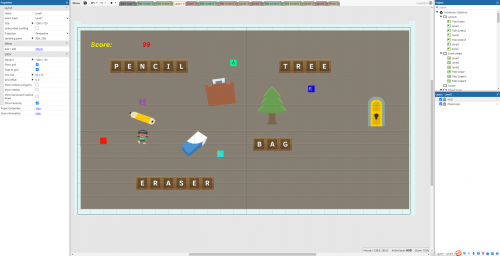
Level 1: match the graphics to the words
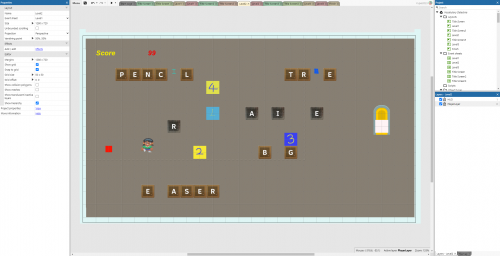
Level2: finish the word spellings
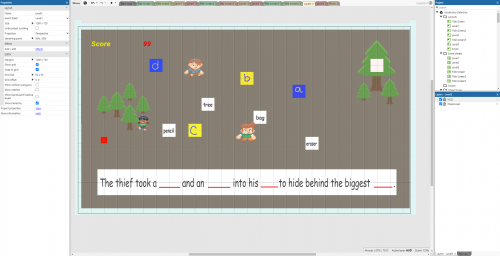
Level3: finish the sentence.

Game Overview
In this game, you will play as a detective to match the right graphics with the right words, to finish the word spellings, and to compose your sentences with the given words. The sentence you finally finished composing contains the clues of the hidden place of the thief, based on that, you will find the thief as a successive detective.
Learner/Player
The intended users are Grade 3 students in primary schools at Columbia, Missouri. They are 7-8 years-old girls. The boys will play another version of the game with different boy-player graphics. Other elements of the game will be the same. The kids are learning to spell new words related to learning tools. No need so much game experience for playing this game, only can use 4 different direction buttons to control the player to different directions when it is necessary. For the subject matter knowledge, the learners should know the right spellings of the common learning tools.
Subject Area
English Language Arts
Knowledge Domain
Declarative knowledge and rules-based knowledge(Kapp, 2012) are my game’s learning domains.
Declarative knowledge
- Matching: match the word to the picture which shows its meaning.
- Repetition: to find the right letters to finish the given words.
Rules-based knowledge
- Experience Consequences: Compose the correct English sentence with the given words.
Learning Objectives
Instructional objective: Grade 3rd students will be able to compose a simple English sentence by using the given words.
Supporting objectives:
- After playing the game, the players will be able to match the right graphics with the relative English words.
- After playing the game, the players will be able to correctly spell the given English words.
Game Goal
The overall goal of playing the game is to assist Grade 3rd students to learn and review common English words; practice composing English sentences. The players will try to use less time to remember the meaning of the words, familiarize the spellings, then try to use the words to compose sentences correctly. The more accuracy and the less time cost will gain extra points.
Game Description
This is a “Sokoban style” (pushing box) game. The player will experience three game levels. Firstly, to push the graphics to the relative English words, once a graphic matches to the correct word, the player gets the reward points. After playing, the player will learn or review the English words and remember their meanings. Second game level, the player will push the missing letter(s) to finish the word spellings they have seen in the first level. In this level, the players will get more chances to be familiar with the words. Third game level, based on understanding the meanings of the words and their spellings, the player will push the words to the right place(s) to finish an English sentence. The finished English sentence will tell the clues of the hidden place of the thief. The players will find the thief with understanding the meaning of the English sentence. Finally, the thief will be caught by the vocabulary detective with the help of police men and teachers.
Environment
It’s a half-realistic and half-fantastic game that takes place in an elementary school named G school (Fig.1).
Fig.1 Game Environment
The player will see a classroom with messy graphics and English words. A message from the teacher tells her that a thief stole items from the classrooms. The second classroom has English words with missing letters. The player will compose the English sentence in the third classroom and find the clue of the hidden location of the thief.
Story/Narrative
There is a story that helps players engage with the game. One dark night, a thief stole some valuable knowledge, made the items of instruction and learning in the classrooms a total mess in G School. The next morning, a Grade 3rd student asks to help teachers reorganize the teaching and learning items in the classrooms. The player will manipulate the four direction buttons on the keyboard to put everything back to the proper places. The player will see the graphics of the english words, English words, English words with missing letters, English sentences with missing words in different scenarios. The play will push the messy items which were disturbed by the thief to the original places, then find the lost items to report to police.
The purpose to keep the players moving forward is to save more time to report the missing items in the school to police. The faster the vocabulary detective finishes the matching, the quicker the police will understand the real loss in the campus to take action to catch the thief.
The climax of the story is using the right words to compose a correct sentence, which is based on the understanding of the meaning and usage of the words. The sentence is the clue to the thief’s hiding place. If the player understands the sentence correctly, he or she will help police find the thief more easily. The rising actions are being familiar with the meaning of the words in the first and second scenarios. The game helps foster students’ English vocabulary learning interests.
Characters
The main character is a Grade 3rd student, a vocabulary detective. Except for the main character, there is a thief hiding somewhere in G school, a teacher and a police officer who are searching for the thief.
The thief is a challenge in the game to arouse the passion of playing and learning. The teacher and the police officer are Non-player characters who are also very important components of this educational game. In real life, the kids are not recommended to face the criminals directly. The right way for them in this scenario is to report to adults or police officers.
Core Dynamic
Race to the finish, and Matching.
Gameplay
Core loop: The player will control a detective (sprite 1) to use the clues (English sentence) to resolve the crosswords puzzles and match the relative graphics, then use the words to compose an English sentence as soon as possible. Each correct match will add the score.
Action: The players will manipulate the four different directions buttons to control the spite to finish the tasks in the game.
Scoring, Reward, Assessment
Scoring: The initial score is 100 points. Each correct word matching will add 10 points, and each correct sentence matching will add 20 points. Meanwhile, each wrong matching will reduce 10 points.
Reward: The players will start from the game with a 120 seconds back counting timer. The left time will be calculated as extra points, each second equals to one point, to add to the score. The more proficient the player with matching, the higher points the player will get. The top 3 achievements will be recorded and will be viewable to other players.
Assessment : The game system will evaluate the players on their speed and accuracy when they successfully finish all the right matchings.
Gee Principles
- Identity – Clear goals and clear roles, games invite you to take on different roles and invite you to become different people and try new activities(Why Game Based Learning Will Make Your Child Smarter?, 2020).
In my game, I want to invite the players to take the role of a sort of superhero to help the police officer and school faculty to find the thief. Knowledge is powerful.
- Empowered Learners – learners must feel like what they do matters(Why Game Based Learning Will Make Your Child Smarter?, 2020). I hope the players can really use daily learning in their classrooms to resolve problems.
Description of Planned Construct 3 Game Implementation
I have been designing two letters and two objectives the letters should be pushed to by the player. If the right letter were pushed to, the system will add 10 points to the score, instead of the wrong letter being pushed to, then 10 points will be decreased from the total score. The same logic will be copied to more letters, graphics and word sprites.
There are some tutorials, resources I have been using
- Platformer game design tutorial: https://www.construct.net/en/tutorials/platformer-game-2329
- Top-down shooter game (score function) design tutorial: https://www.construct.net/en/tutorials/beginners-guide-construct-1
- Pushing box in construct 3 tutorial: How to make pushing box in Construct 2 & Construct 3 – YouTube
- Resource: Toon characters 1: Toon Characters 1 · Kenney
- Resource: Sokoban: Sokoban · Kenney
- Resource: Generic items(deceleration):Generic Items · Kenney
- Resource: Letter Tiles:Letter Tiles · Kenney
- Resource: Puzzle pack:Puzzle Pack · Kenney
Screenshots
Fig 2. Code event sheet
Fig 3. Play view
References
Tutorial
Sound and background music :https://www.youtube.com/watch?v=X6y0lTeOURE
Countdown timer: https://www.youtube.com/watch?v=V8BRbEJP7e8
Assets:
Audio:https://www.kenney.nl/assets/category:Audio?sort=update https://www.kenney.nl/assets/impact-sounds
Background music:https://freesound.org/
Read MoreLevel 4-Reflect on Digital Design Process: Vocabulary Detective Game Design
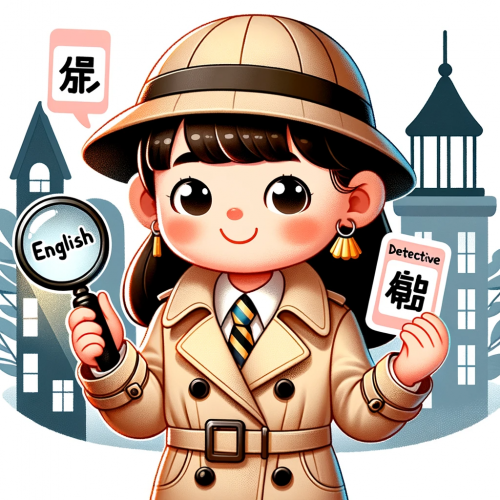
(Fig. 1 Vocabulary Detective. Designed and Created by Yupei Duan and ChatGPT )
While studying Level 4 of the Designing Games for Learning course, I have been reading the book Reality is Broken: Why Games Make Us Better and How They Can Change the World, written by Jane McGonigal (McGonigal, 2011). There were a lot of ideas in the book that needed to be pondered during designing serious games. During the process of designing my game on Construct 3, I have been pondering this idea from the book, “a game designer and researcher should be aware that video-games are not just entertaining and addictive but also can be powerful tools for solving real-world problems.” Life is full of problems. Learning a new language is one of them that I am resolving in my real life.
In my family, there is a daily online activity hosted by my elder daughter starting from December of 2022 to now, every night, the little girl teaches English words or sentences by leaving voice messages in a social media group where I, my wife, my parents, and my parents in law will receive the messages and learn the relative content, then respond to our own English reading practice via sharing voice messages in the group. A virtual online platform unites all the family members together with doing this simple activity. How can I make this activity more interesting? How about designing a video-game based on this online activity?
When I started to design my game on Construct 3, the initial idea was to make a bilingual vocabulary game to let the players (like my daughter, my parents and parents in law) can play the game to review the vocabularies they have learned. However, just matching the right translation to the expressions is hard to reach some high-level instructional objectives. While checking the English Language Arts (ELA) Priority Standards (Priority Standards – English Language Arts, n.d.), I found there were very clear expectation to the students’ understanding of vocabulary:
- Using sentence-level context to determine the relevant meaning of unfamiliar words or distinguish among multiple-meaning words
- Distinguishing the literal and nonliteral meanings of words and phrases in context
- Using conversational, general academic, and domain-specific words and phrases
In the coming year, my elder daughter will go to 3rd grade in Columbia’s local primary school. Why don’t I design a game for her to warm up for the upcoming school year English vocabulary learning? At the same time, other family members will be familiar with my daughter’s learning content. So, I changed the educational goal of the game from simple translation to resolving crossword puzzles.
Reflect on your process for designing the mechanics for your game.What worked best, what didn’t?
During the process of designing my game, I found the following mechanics worked best for me:
- Points: the player can see the real-time points from the game.
- Storytelling and Narratives: an introduction scene will show in the beginning of the game to tell the background of the game. During the game playing, the player will compete with the villain to finish resolving the crosswords puzzles. At the end of the game, the player will see the result of competition with the villain.
- Feedback Systems: the player will hear the sound and see the effect diagram when the puzzles are resolved.
Some mechanics I wanted to use but failed, for example: badges and achievements, leaderboards, collaboration and teamwork, etc.
If you had to do this process over again, what would you change? If nothing, why not?
If I had a chance to redesign the game, I would like to delve deeper into the ELA Standards in Missouri first, then to find more proper content to design the game. Besides that, I would like to read more game-design papers related to ELA learning. Based on recent research progression, I would design a higher value educational game.
What did you learn from the Construct 3 implementation aspect of the project?
Currently, I am still a novice user of Construct 3, the more tutorial videos I watch, the more potential functions of Construct 3 I can find. I think it’s a friendly and convenient game design platform, in which the users can design games on chrome. The design technologies are based on coding logic but don’t need the designers to have high coding skills to start.
How has this game design process differed from your previous game design experiences?
Compared with Twin, an open-source tool for telling interactive, nonlinear stories, construct 3 contains more dimensional interactions with the players. More real-time feedback could be easily fulfilled in Construct 3, like animations, interactive effects, etc, which would be hard to have in Twin.
Digital Game Details:
- Game title: Vocabulary Detective
- Subject area: English Language Acquisition
- learning objective:
- After playing the game, the players will be able to correctly spell the given English words.
- After playing the game, the players will be able to match the right graphics with the relative English words.
- After playing the game, the players will be able to compose a sentence using the given English words.
- Game goal: learn and review english words; practice composing English sentences.
- Core dynamic: Race to the finish, and Matching.
- Mechanics: Points; Storytelling and Narratives; Feedback Systems.
- Assessment : The game system will evaluate the players on their speed and accuracy when they successfully finish all the right matchings.
- Scoring: The initial score is 100 points. Each correct word matching will add 10 points, and each correct sentence matching will add 20 points. Meanwhile, each wrong matching will reduce 10 points.
- Reward: The players will start from the game with a 120 seconds back counting timer. The left time will be calculated as extra points, each second equals to one point, to add to the score. The more proficient the player with matching, the higher points the player will get. The top 3 achievements will be recorded and will be viewable to other players.
What is the core loop you want players to experience in your game?
The player will control a detective (sprite 1) to use the clues (English nouns) to resolve the crosswords puzzles and match the relative graphics, then use the words to compose an English sentence as soon as possible. Each correct match will add the score.
Show off your Prototyping!
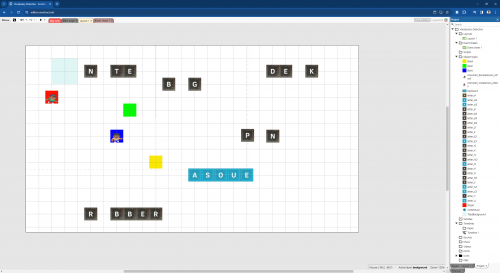

Fig 3. Working progression 2 on Construct 3
Peer responses
What did your peers have to say about your game design?
Comments from Dr. Oprean:
Bilingual Detective is an exciting title, Yupei. For your intended learning objectives, I am not seeing either one as being entirely higher-order. Translate can be closer to higher order but it generally falls into lower-order by itself. Maybe what players do with the translation activity would make it higher-order? For reference, the following chart may be helpful – https://tips.uark.edu/blooms-taxonomy-verb-chart/
You have a lot of nice elements in this game idea so far, though I wonder if you could contextualize those elements a bit more so there is continuity between them that makes it easier for the player. Such as the Timer – why is there a Time Element for this? The element should connect with something related to the game goal and context – maybe something along the lines of being a detective and needing to resolve a clue before the villain gets away?
The translated word matching is a nice mechanic. I would think there should be some devising involved given the detective context though. Something like putting the translated words together to determine who the thief or criminal/villain is? This would change the core dynamic slightly but that is something to consider.
Could the scoring also be something that is more contextualized with a detective game? Such as clues solved or tracking the progress of decoding the information (which may still use the same scoring system you indicated).
For the prototype, a shooter game is an interesting idea and not one I would have thought of for a detective game. I would want to see something beyond changing what players shoot from the Ghost Shooter tutorial as well – so perhaps that is where you can consider what about the game makes the player a Detective and see if you can demonstrate some (not all) of that in one round of the game.
You are off to a good start here and I’m looking forward to seeing where your idea goes.
Comments from Leeann Grace:
- What did you like about the idea?
I like the idea of Bilingual Detective, as it combines language learning with gamification, making the process more engaging and interactive.
- What suggestions do you have for them to improve the idea? (this can be in many forms including providing any resources you may have found that would be helpful in prototyping!)
Diversify Learning Modes: Consider incorporating different learning modes, such as auditory and visual cues, to accommodate various learning styles.
Progressive Difficulty Levels: Implement a system where the difficulty level increases as the player progresses, keeping the game challenging and ensuring a continuous learning curve
- Does the assessment appear to test the learning objectives?
Testing Learning Objectives: The game seems to effectively test the learning objectives related to matching English nouns with graphics and translating English sentences into Chinese. The speed and accuracy metrics align well with the language acquisition goals.
- What comments do you have on the scoring and rewards as motivating the player to keep playing?
Feedback on Scoring: Include a detailed breakdown of the score, specifying points earned for each correct match and deductions for incorrect ones. This transparency can help players understand their strengths and areas for improvement.
Were there any useful suggestions to help you move forward?
Both Dr. Oprean and my classmate Leeann gave me very valuable recommendations. Based on them, I have been improving my game development and design documents. The comments about designing teaching objectives from Dr. Oprean helped me think how to design a challenging and educative game, but not only a simple and funny game for the players (learners). After checking some papers about designing games for ELA learning, I found it was a huge research area. I am still on the road.
Like a hangman game showed that Hangman Game can improve the students’ understanding of the meaning of the words, besides that the students also can master the words based on the context given. It also helps a lot with the practice of vocabulary and spelling in children. The game exposes students to practice the alphabet and remember the vocabulary learned in classes. From this paper (Martono et al., 2013) I understood that time limitation is a very important game mechanic.
Flashcards have always been very useful when teaching children interactively. In the article the author writes about the benefits of GBL in children and states that GBL is known to sharpen the memory of kids by 90% and also says that Learning concepts through visual learning leads to better retention power and sharpens the minds of kids, which allows them to improve their memory. Using cards in the classroom as competition will awaken in children the need to play and win. Some elements from the article (Why Game Based Learning Will Make Your Child Smarter?, 2020) I would like to use in my game design in the future.
References
Priority Standards—English Language Arts. (n.d.). Retrieved November 30, 2023, from https://sites.google.com/view/priority-standards-mo-dese/home/english-language-artsWhy Game Based Learning Will Make Your Child Smarter? – EdTechReview. (2020, July 23). https://www.edtechreview.in/trends-insights/trends/why-game-based-learning-will-make-your-child-smarter/
Read MoreLevel 3 – Iteration Equals to Rebirth
“What you get by achieving your goals is not as important as what you become by achieving your goals.”
– Zig Ziglar
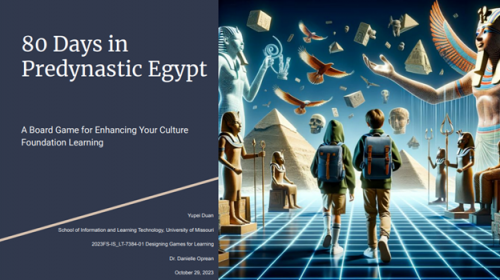
Iteration and rebirth can be seen as similar in the sense that they both involve a process of renewal and transformation. During the ongoing progress of the course “Designing Games for Learning”, I felt that not only did my games undergo multiple iterations, but my mind also experienced numerous rebirths throughout the same process.
On level 3, I used the games from Level 1 I played as mentor games to design my board game. All the competencies I relied on were from previous practices, readings, discussions, and assignments. I could see my board game more and more clearly approaching to the submission deadline. I hoped to make it better, but the time was always limited. So, I will just record the current status of my board game 80 Days in Predynastic Egypt here in my blog, and waiting for the next round iteration for the game.
Analog Game Design & Prototype Video (7384)
- Game Title:80 Days in Predynastic Egypt
- Video Introduction: https://www.youtube.com/watch?v=_GEB_nXqdNA
- Subject area: History & Geography
- Learning domain, learning goal/objective: The architectures, religious system, and civilization development in Ancient Egypt
- Who are the players: Students in Grade 4- Grade 8 who have recently learned about Predynastic Egypt. The student players will form groups, each group consisting of 3 to 4 students.
- Premise of the game: Hi students, many of you are familiar with Magic School Bus, which is the title of a series of fictional scientific books. In this game, 80 Days in Predynastic Egypt, a board game will give you a chance to get on the magic school bus to have a virtual venture in Ancient Egypt, and I will be your driver. During the game, you will use your learnt knowledge about ancient Egypt to embark on your group adventure, you and your group members will be invited to share your journey after the game. Are you ready?!
- Game Goal. To resolve the problems related to Egyptian civilization in 80 turns and create a team story to introduce Predynastic Egypt based on the questions and learning from the culture foundation course.
- Learning Objectives.
Learning objective 1: To use the knowledge learnt from the Culture Foundation course to resolve the problems in the game.
Learning objective 2: To create a group-made Predynastic Egypt journey report for all players.
- Content.

A game board contains 80 grids on behalf of 80 turns(days) in the game.

There are three different icons on the board on behalf of different challenges: Civilization Development Challenges, Religious System Challenges, and Architecture Challenges.

The reward cards and penalty cards will bring random affairs related to Ancient Egypt to increase or decrease the players time travel opportunities. When the players have more chances to do the time travel, they can have more opportunities to explore in Ancient Egypt to discovery more knowledge with holding the reward cards. And the penalty cards will shorten the players time travel journey, then the players will have less chance to find more details for their final group presentation.
- Setup. Before the game begins, the student players will form groups, each consisting of 3 to 4 students. During the game, each group of students will represent a group of tourists, and they will roll the dice to determine their pace in the virtual journey through Predynastic Egypt. The game board features illustrations on the grids that depict challenges, bonuses, or penalties, all of which are related to the real history, civilization, and religion systems of ancient Egypt. Some grids will lead the players to check the “Reward” or “Penalty” cards to add more story details, random and fun.
- How to Play. In a turn, the player will roll the dice, then move the Player chess to the relative grid according to the number on the dice, then the player will check the information on the grid. Different grids contain different information, like: penalty, reward, common step, which will lead the player to check relative cards or information to compose a journey story (Core loop). Each round of the game will be finished in 80 turns. Then, all the players will collaborate to solve problems and use their game experience to create a presentation that introduces their virtual journey, helping them learn and review knowledge about predynastic Egypt.
- End of Game. The game will be over when all the players share their stories after finishing all the grids on the boards. The teacher will lead the students to reflect all the learnings they covered in the Ancient Egypt module in the culture foundation course.
- Statement about Learning.
Game Elements Embedded in 80 Days in Predynastic Egypt
Goals: The simple introduction of a goal adds purpose, focus, and measurable outcomes (Kapp, 2012, p. 68). In my game, the instructors from the Culture Foundation class will illustrate the game goals which are helping students eager to explore using their learnt knowledge. This game is another way to assist students to retrieve. The fact that retrieval practice, spacing, rehearsal, and the construction of mental models improve learning and memory is evidence of neuroplasticity and is consistent with scientists’ understanding of memory consolidation as an agent for increasing and strengthening the neural pathways by which one is later able to retrieve and apply learning (Brown et al., 2014, p. 172).
Conflict, Competition, or Cooperation: While it is helpful to consider the elements of conflict, competition,and cooperation separately, often good game design includes elements of all three (Kapp, 2012, p. 73). The student player will cooperate with the group member to develop their virtual journey stories. They need to resolve the conflicts together when they encounter some challenges while playing. During the showcase session, friendly competition will happen between different groups, while the student player will learn other teams’ stories to enhance their own to improve their learning.
Feedback: during the showcase session, the audience including the students and teachers will provide feedback to the storytellers as feedback to improve their understanding about Ancient Egypt.
Storytelling: storytelling plays a very important role in the serious game. All the students need to consider how to compose their adventure story while playing the game. As an educator, if I just ask my students to engage in mechanical repetition, they quickly hit the limit of what they can keep in mind. However, if they practice elaboration, there’s no known limit to how much they can learn. Elaboration is the process of giving new material meaning by expressing it in their own words and connecting it with what they already know. The more the students can explain about the way their new learning relates to their prior knowledge, the stronger their grasp of the new learning will be, and the more connections they create that will help them remember it later (Brown et al., 2014, p. 5).
The elements of “ALLUE of Play” in 80 Days in Predynastic Egypt
There are a lot of strategies and resources for designing an educational board game in the book The Educator’s Guide To Designing Games and Creative Active-Learning Exercises – The Allure of Play. I considered some simple mechanics or complex mechanic activities introduced in the book to design my game.
Simple mechanics(Bisz et al., 2023)
- Random: The dice, the reward and penalty cards will bring randoms to the players.
- Role: Students will play the roles as time travelers in Ancient Egypt.
- Rival: Students tend to compose their stories to be more vivid, literatical, and informatic to compete with other teams.
Complex mechanic activities(Bisz et al., 2023)
- Trivial Questions: understand through recall and review. Many grids on the board will be linked with questions related to Ancient Egypt knowledge. The students will answer the question to continue the game, while preparing their group story report.
- Brainstorming & Creation: Create a quick list for later appraisal. The student players will form a group to brainstorm their final story presentation.
- Simulation Role-play: Create by identifying with other perspectives. Since some challenges the students encounter will bring the students to a historical context, to let the students play a role and make some decision to continue the game.
- Statement about your Mentor Games.
There are a lot of valuable elements I borrowed from my mentor games 1&2. I didn’t only combined my two mentor games’ names surficial, but deeply merry their main mechanics together. The players can find a lot of similar mechanics in the new board game from Predynastic Egypt and 80 Days, e.g. budget plan (resource management mechanics); route selection (control mechanics); dialogues (progression mechanics); turning setting (control mechanics); random affairs (uncertainty mechanics); real historical affairs (progression mechanics).
- Credits. This board game is similar to Monopoly (“Monopoly (Game),” 2023) but it follows a single direction along the chronological development of Ancient Egypt in each round. The target audience is students in grades 4 to 8 who have recently learned about Predynastic Egypt, and can use this board game for review. In my game, 80 days in Predynastic Egypt, the “Chance” and “Community Chest” cards from the original Monopoly will be replaced with “Reward” and “Penalty” cards.
References:
Appendix:
Knowledge about Ancient Egypt on the challenge, reward, and penalty cards (Created by ChatGPT, revised by Yupei Duan).
1. Architectures:
Pyramids: The most iconic structures of ancient Egypt. The Great Pyramid of Giza, built for Pharaoh Khufu, is one of the Seven Wonders of the Ancient World and showcases the precision and architectural prowess of ancient Egyptian builders.
Temples: These were centers for worship and ceremonies. Famous temples include the Temple of Luxor, Karnak Temple, and the Temple of Horus at Edfu. These structures had massive columns, intricate carvings, and were often aligned with celestial events.
Tombs: The Valley of the Kings and Valley of the Queens are famous for their underground tombs, including that of Tutankhamun. These tombs were elaborately decorated with frescoes that narrated the life of the deceased and prayers for the afterlife.
2. Religious System:
Polytheism: Ancient Egyptians practiced polytheism, with a pantheon of gods and goddesses. Each deity had specific roles, and their importance could change over time.
Afterlife: The belief in the afterlife was strong. This is evident in the mummification process, where the body was preserved for the soul’s journey in the afterlife. The Book of the Dead provided spells and instructions for this journey.
Priesthood: Priests played a significant role in society. They conducted rituals, maintained temples, and were intermediaries between the people and the gods.
3. Civilization Development:
Ancient Egyptian civilization can be divided into several periods:
Predynastic Period (c. 6000-3150 BCE): Settlements began along the Nile, with farming communities flourishing due to the fertile land.
Early Dynastic Period (c. 3150-2613 BCE): This saw the unification of Upper and Lower Egypt under Pharaoh Narmer. The concept of a centralized state began to form.
Old Kingdom (c. 2613-2181 BCE): This period is known for the construction of the pyramids. There was a strong centralized government, and the pharaoh was seen as a divine ruler.
Middle Kingdom (c. 2050-1710 BCE): After a phase of decentralization, the Middle Kingdom saw a reunification and a resurgence in art, literature, and building projects.
New Kingdom (c. 1550-1070 BCE): This was the golden age of ancient Egypt, with powerful pharaohs like Ramses II and Amenhotep III. The empire expanded, and there was significant architectural and cultural development.
Late Period (c. 1070-332 BCE): This period saw invasions by foreign powers, including the Nubians, Assyrians, and Persians. Nevertheless, Egyptian culture persisted.
Ptolemaic Period (c. 332-30 BCE): This began after Alexander the Great’s conquest and lasted until the Roman conquest. It saw a fusion of Greek and Egyptian cultures.
Read More